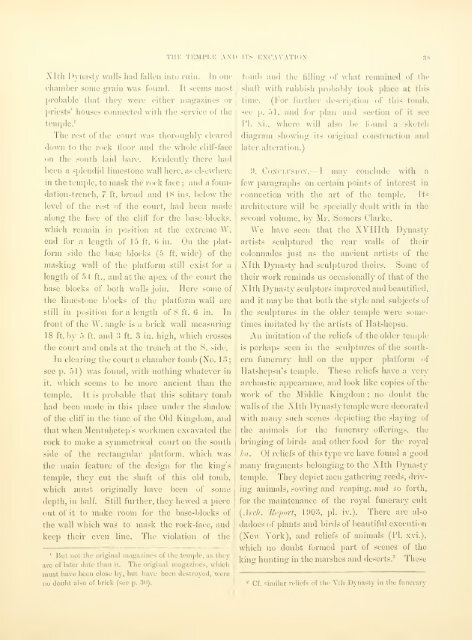The XIth dynasty temple at Deir el-Bahari .. - NYU | Digital Library ...
The XIth dynasty temple at Deir el-Bahari .. - NYU | Digital Library ...
The XIth dynasty temple at Deir el-Bahari .. - NYU | Digital Library ...
You also want an ePaper? Increase the reach of your titles
YUMPU automatically turns print PDFs into web optimized ePapers that Google loves.
Xlth Dynasty walls had lalluu iutu luiii. In one<br />
chamber some grain was fnund. It seems most<br />
probable th<strong>at</strong> they were either magazines or<br />
priests' liouses connected with the service of the<br />
<strong>temple</strong>.'<br />
Tlic rest of the court was thoroughly cleared<br />
down to the rock Hour ami the whole clid-face<br />
on the south l.iid Imre. Kvidently tliere had<br />
])een a splentlid limestone wall hei-e, as <strong>el</strong>sewhere<br />
in the <strong>temple</strong>, to mask the rock face ;<br />
TlIK TKMI'IJO AM" IT- ;X('.\VATIi)X. 39<br />
and a foun-<br />
d<strong>at</strong>ion-trench, 7 ft. broad and IS ins. b<strong>el</strong>ow the<br />
lev<strong>el</strong> of the rest of the court, had been made<br />
along the face of the clift' for the base- blocks,<br />
which remain in position <strong>at</strong> the extreme W.<br />
end for a length of 15 ft. (5 in. On the pl<strong>at</strong>-<br />
form side the base blocks (.5 ft. wide) of the<br />
masking wall of the pl<strong>at</strong>form still exist for a<br />
length of 54 ft., and <strong>at</strong> the npcK of the court the<br />
base blocks of both walls join. Here some of<br />
the limestone blocks of the pl<strong>at</strong>form wall arc<br />
still in position for a length of iS ft. G in. In<br />
front of the AV. angle is a brick wall measuring<br />
18 ft. by .') ft. and 3 ft. 3 in. high, which crosses<br />
the court and ends <strong>at</strong> the trench <strong>at</strong> the S. side.<br />
In clearing the covu't a cliamber tomb (No. lo<br />
see p. 51) was found, with nothing wh<strong>at</strong>ever in<br />
it. which seems to be more ancient than the<br />
<strong>temple</strong>. Tt is probable th<strong>at</strong> this solitary tomb<br />
had been made in this place under the shadow<br />
of the cliff in the time of the Old Kingdom, and<br />
th<strong>at</strong> when Mentuheteps workmen excav<strong>at</strong>ed the<br />
rock to make a symmetrical coiu't on llie south<br />
side of the rectangular pl<strong>at</strong>form, which Avas<br />
the main fe<strong>at</strong>ure of the design for the king's<br />
<strong>temple</strong>, they cut the shaft of this old tomb,<br />
wliich mnst originally have been of some<br />
depth, in half. Still further, they hewed a piece<br />
out of it to make room for the base-blocks of<br />
the wall wliich was to mask the rock-face, and<br />
keep their even line. <strong>The</strong> viol<strong>at</strong>ion of the<br />
' But not the original magazines of the <strong>temple</strong>, as they<br />
are of l<strong>at</strong>er d<strong>at</strong>e than it. <strong>The</strong> original magazines, which<br />
must have been close by, but have been destroyed, were<br />
no doubt also of brick (see p. 30).<br />
;<br />
tomb and the tilling of wh<strong>at</strong> remained of the<br />
shaft with rubbish probably took place <strong>at</strong> this<br />
time. (For farther description of this tomb,<br />
see p. .")1, and for phin and section of it sec<br />
PI. .\i., where will also be found a sketch<br />
diagram showing its original construction and<br />
l<strong>at</strong>er alter<strong>at</strong>ion.)<br />
9. CoNOLUSiox.—I may conclude with a<br />
few paragraphs on certain points of interest in<br />
connection with the art of the <strong>temple</strong>. Its<br />
architecture v.ill be specially dealt Avith in the<br />
second volume, by Mr. Somers Clarke.<br />
We have seen th<strong>at</strong> the XVII Ith Dynasty<br />
artists sculptured the rear walls of their<br />
colonnades just as the ancient artists of the<br />
Xlth Dynasty had sculptured theirs. Some of<br />
their work reminds us occasionally of th<strong>at</strong> of the<br />
Xlth Dynasty sculptors improved and beautified,<br />
and it may be th<strong>at</strong> both the style and subjects of<br />
the sculptures in the older <strong>temple</strong> were some-<br />
times imit<strong>at</strong>ed by the artists of H<strong>at</strong>shepsu.<br />
An imit<strong>at</strong>ion of the r<strong>el</strong>iefs of the older <strong>temple</strong><br />
is perhaps seen in the sculptures of the south-<br />
ern funerary hall on tlio upper pl<strong>at</strong>form of<br />
H<strong>at</strong>shepsu's <strong>temple</strong>. <strong>The</strong>se r<strong>el</strong>iefs have a very<br />
archaistic appearance, and look like copies of the<br />
work of the Middle Kingdom; no doubt the<br />
walls of the Xlth Dynasty <strong>temple</strong> were decor<strong>at</strong>ed<br />
with many such scenes depicting the slaying of<br />
the animals for the funerary offerings, the<br />
brincjino; of birds and other food for the roval<br />
/,•(/. Of r<strong>el</strong>iefs of this type we have found a good<br />
many fragments b<strong>el</strong>onging to the Xlth Dynasty<br />
<strong>temple</strong>. <strong>The</strong>y depict men g<strong>at</strong>hering reeds, driv-<br />
ing animals, sowing and reaping, and so forth,<br />
for the maintenance of tlie royal funerary cult<br />
{Arch. liepurt, lOOo, pi. iv.). <strong>The</strong>re are also<br />
dadoes of plants and birds of beautiful execution<br />
(Xew York), and r<strong>el</strong>iefs of animals (V\. xvi.),<br />
wliicli no doubt formed part of scenes of the<br />
kinir huntini;- in the marshes and deserts." <strong>The</strong>se<br />
- Cf. similar r<strong>el</strong>iefs of the Vth Dynasty in the funerary

















